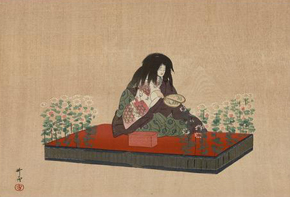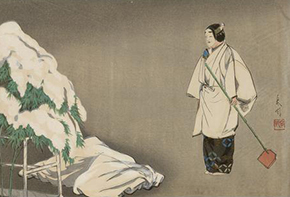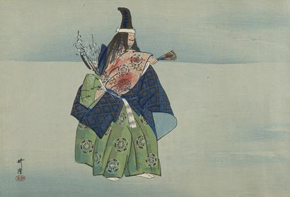能画大鑑 Nōga Taikan
Nōga Taikan (A Great Collection of Prints of Noh Plays) was published in Tokyo between 1925 and 1930. The original designs for Volumes 2 through 5 were drawn by Kōgyo, but the drawings for twenty-four of the prints in Volume 1 were created after Kōgyo’s death by Matsuno Sōfū, Kōgyo’s very talented protégé. The University of Pittsburgh Library System owns a complete set of these five volumes, two-hundred prints in all, gifted to them by Professors Emeriti Richard and Mae Smethurst. These prints were not published by Matsuki Heikichi and his Daikokuya publishing company, but by another company, Seibi Shoin, also of Tokyo.
The five volumes of two hundred prints (forty in each volume) are covered in beige silk twill and the prints are tied into the bindings by silk cords, brads, and internal stitching. In fact, the University of Pittsburgh Library System bought a revised edition of Nōga Taikan published in 1936, one in which the prints were bounded as one volume, so that it was easy to unbind it for the digital photocopying without damaging the prints or the beautiful bindings of the Smethurst volumes. (Originally bought by the Smethursts at Takayama Shoten in Jinbōchō, Tokyo.)
The original volumes are currently in the Archives & Special Collections of the Hillman Library. Each print is a scene from the noh play represented, similar to the same scene as it appeared on stage. Of Kōgyo’s three sets of noh prints, the Nōga Taikan prints seem to show the plays more accurately than either Nōgaku zue or Nōgaku hyakuban. In fact, if he sketched plays in the noh theater using brush and black ink, as his daughter Gyokusei said he did, he must have made notes to himself somewhere about what colors and designs to use on the costumes and stage props. The prints are very simple: the main actors at an important moment in the play, the artist’s signature, and the artist’s seal. The prints reveal at most few parts of the stage and its backdrop, and when so, only faintly. The focus is on the actors qua actors The prints do not reveal the name of the plays represented, but each print in all five volumes is preceded by a piece of translucent paper on which the title of the play, the actors by type (shite, waki, tsure, kyōgen, kokata) and name of character in his role appear in Japanese. These supplemental data were printed using modern, movable type, not by carving on woodblocks. In other words, Nōga Taikan seems to be a combination of the older and newer technologies in producing texts, artist’s name and seal by carved block, explanatory material by typesetting and printing. Unlike Nōgaku hyakuban, produced and marketed by another publishing house also in the 1920s, there is no English on either print or translucent paper. It would appear that the publisher at Seibi Shoin had only a Japanese audience in mind.
Who was that Japanese audience? As we have written elsewhere, noh was transformed after the fall of the last shogunal regime (1867) from a theater form popular among the samurai elite to a theater form that also appealed to the new bourgeois elite, which grew up as rich merchant houses strove to turn Japan into an advanced industrial state—the large and beautiful collection of noh masks and robes in the Mitsui Museum in Nihonbashi, Tokyo is demonstrative of this. But in the 1920s, as Japan moved into the modern, entrepreneurial world, noh became popular with the new, urban middle class, the new haute bourgeoisie. Members of this group began (and still do today) to take lessons in noh performance. Could it be members of this group who bought prints or volume of prints from Nōga Taikan?
Richard Smethurst - Emeritus Professor - University of Pittsburgh
Debra Taylor Cashion - Associate Professor, Digital Humanities Librarian - Saint Louis University
- Second Artist
- Other Collections
松野奏風 Matsuno Sōfū
ūOne of Kōgyo’s two primary disciples as a painter of noh was Matsuno Sōfū 松野奏風 At birth in 1899, Sōfū was named Tokutarō 徳太郎, but he took the name Sōfū when he became an artist. Sōfū liked painting as a child, went to the First Tokyo Middle School, and studied art with Otake Kokkan 尾竹国観 at the same time. At sixteen, he studied with Tsukioka Kōgyo, at first drawing pictures of people and scenery. After military service, he committed himself to noh. In 1924, with recommendations from Yamazaki Gakudo and Sakamoto Setchō雪鳥, Sōfū published noh pictures for the first time and got good reviews. In the early Shōwa period, he completed the final 24 prints for Kōgyo’s final set of prints, Nōga Taikan, after his mentor’s death in 1927.
In 1929, Sōfū did the illustrations for the Kanze School’s Kanzeryū Shōwaban 観世流昭和版. In 1937, he took charge of the illustrations for the Kanzeryū Taiseiban Utaibon 観世流大成版謡本. He was the first to produce illustrations for noh texts 挿絵. Kanze Sakon made the decision to include black and white pictures with the texts, and thus Sōfū’s brush played a big role in popularizing noh. He continued to do prints and paintings of noh plays until his death in 1963. In addition, after World War II, he painted over 20 pines for the backdrops of stages, including the pine on the backdrop of the stage at Hakusan Shrine at Hiraizumi. https://bunka.nii.ac.jp/heritages/detail/186086/2
First Editions
First edition of Nōga taikan is a five-volume set with 200 prints and 200 synopses of Noh play. Volumes 2 through 5 were published in 1925 and 1926 with drawings by Kōgyo. However, volume 1 was published in 1930, three year later from Kōgyo’s death, with 24 out of 40 prints by Matsuno Sōfū, Kōgyo’s very talented protégé. The collections that own complete set of the first edition include:
- New York Public Library, Performing Arts Research Collections
- National Noh Theatre of Japan
- Hosei University, Noh Study Research Center, Japan
- Waseda University, Tsubouchi Memorial Theatre Museum, Japan
- Kobe Chuo Municipal Library, Japan
- Tokyo University Library, Japan
- Hiromae University Library, Japan
- Musashino University Library, Japan
Revised editions (改版 kaihan)
There are at least three versions of revised edition published in 1936. The collections that own one of those versions include:
- Harvard University, Fine Art Library, Boston (1 volume with 200 prints)
- The Lavenberg Collection (4 volumes set with 160 prints)
- University of Iowa (unbound, 133 prints)
- University of California, Berkeley (2 volumes set with 93 prints)
- University of California, Los Angeles (1 volume with 50 prints)
- University of Southern California (1 volume with 50 prints)
- Brigham Young University (1 volume with 50 prints)
Another Revised Edition in 1937
According to the bibliographic record of the British Library, this edition has additional title as Nōga taikan: nōga nihyakuban ōzoroe (能畫大鑑 : 能畫貮百番大揃, Nōga taikan: 200 prints of Noh play). The record also shown that it is a revised edition of the work originally published in 1934. However, I cannot find the work published in 1934 so far.
- British Library, London (1 volume set with 200 prints) https://explore.bl.uk/BLVU1:LSCOP-ALL:BLL01017699018
University of Pittsburgh Library System owns two set of Nōga taikan: first edition of five-volume set with 200 prints and revised edition of one volume with 200 prints.
We would greatly appreciate information about additional sets of Nōga taikan in collections known to you.
Hiroyuki Good, Japanese and Korean Studies Librarian, UUniversity of Pittsburgh Library System








